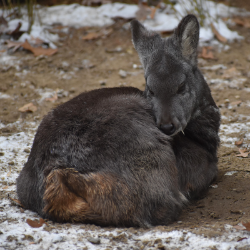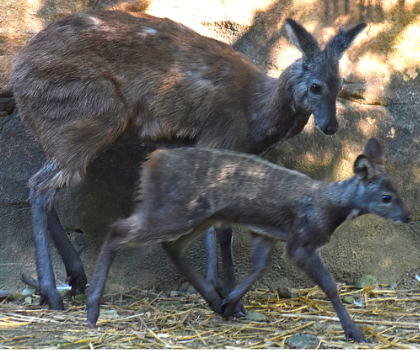 The taiga biome is the largest terrestrial biome in the world. This environment is often swampy and cold since it is located in high latitudes like the Himalayan mountains. Most of us would imagine this chilly habitat to be filled with large mammals with thick fur, such as reindeer, lynxes, wolves, moose and bears. While this assumption is not incorrect, there are also a few surprisingly small residents of the taiga. One example is the Siberian musk deer.
The taiga biome is the largest terrestrial biome in the world. This environment is often swampy and cold since it is located in high latitudes like the Himalayan mountains. Most of us would imagine this chilly habitat to be filled with large mammals with thick fur, such as reindeer, lynxes, wolves, moose and bears. While this assumption is not incorrect, there are also a few surprisingly small residents of the taiga. One example is the Siberian musk deer.
A full grown Siberian musk deer is roughly two feet tall and only weighs about 35 pounds. These deer have long, muscular back legs, short front legs and an arched back. Instead of taking long strides, musk deer use their powerful back legs to jump and hop about. Musk deer are most active at twilight or during the night, and they migrate seasonally. They spend their winters in the steep mountain slopes of the Himalayas and they summer in grassy meadows near the mountain river valleys. When they are first born, musk deer have short, dark brown fur with lightly colored spots. Their second winter, they grow their adult winter coat of coarse hair with less defined spots.
 Musk deer are different from many other species of deer in that they do not have antlers. Instead, the males have long canine teeth that protrude from their mouths and extend downward, like a vampire from an old horror movie. These “fangs,” which may reach up to 4 inches long in older males, are used in fights between males over territory and mating rights.
Musk deer are different from many other species of deer in that they do not have antlers. Instead, the males have long canine teeth that protrude from their mouths and extend downward, like a vampire from an old horror movie. These “fangs,” which may reach up to 4 inches long in older males, are used in fights between males over territory and mating rights.
Musk deer are also unique because of their musk pouch. This pouch, which resides between their sex organs and navel, releases a scent called “musk” to help attract a mate during mating season. When the male is producing the musk, it will mix with his urine and turn it pink. Male musk deer are often hunted for this musk, which has been used throughout history as an ingredient in traditional medicine and perfumes.
Musk deer tend to be shy animals who usually live in small groups of two or three individuals, usually a mother and her young. They are an important part of the food chain in the taiga, which could contribute to why they are so secretive. Their shy nature helps them to survive not only natural predators, but poachers as well. The greatest threat facing the musk deer population is overhunting for their musk.
 Even if you can’t travel to the taiga to see a Siberian musk deer, you can still learn more about them at your Akron Zoo! Vlad and Anastasia, our two adult musk deer, have been residents of the Akron Zoo since 2017. Earlier this year, Anastasia also gave birth to a fawn, named Little Bucky, who completes this lovable family of three. Unfortunately, these dear deer are often overlooked by our guests because of their natural inclination to hide.
Even if you can’t travel to the taiga to see a Siberian musk deer, you can still learn more about them at your Akron Zoo! Vlad and Anastasia, our two adult musk deer, have been residents of the Akron Zoo since 2017. Earlier this year, Anastasia also gave birth to a fawn, named Little Bucky, who completes this lovable family of three. Unfortunately, these dear deer are often overlooked by our guests because of their natural inclination to hide.
Since musk deer are most active in the evening or at night, during regular zoo hours they tend to be sleeping or relaxing in the brush. Little Bucky especially loves spending the day napping in the tall patches of grass in his habitat, or curling up between the stones in the habitat wall. Many guests assume that the habitat only contains red breasted geese and emperor geese. However, if you are up for the challenge of playing hide-and-seek with our musk deer, you may be rewarded with a great view of these unique animals!
Stop by your Akron Zoo and take the challenge of spotting our spotted musk deer fawn, Little Bucky! And don’t forget to say hello to your other favorites!
By Erica Rymer, Events & Marketing Specialist. Published August 25, 2019.
